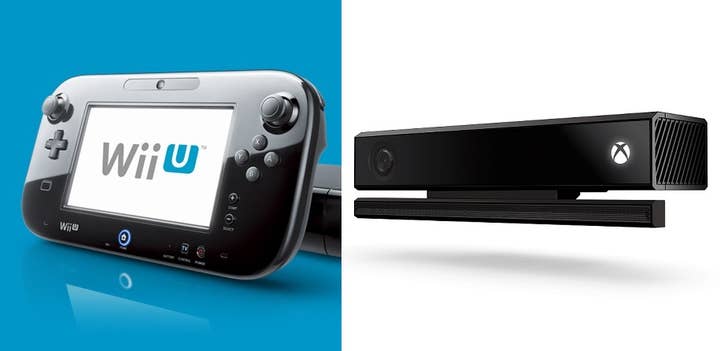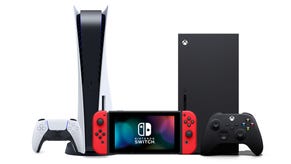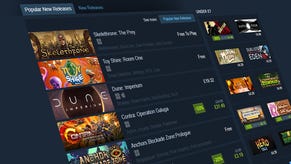Kinect and GamePad are both deadweights
Microsoft and Nintendo have the same problem - expensive peripherals that so far don't improve the experience of their consoles
It's pretty hard to figure out exactly where the new generation of consoles stand in terms of sales right now, but the general picture is clear. PS4, still supply constrained in many markets, leads Xbox One by at least a million consoles sold, possibly as much as two million - so the oft-cited ratio of 1.5:1 seems to be holding. Assuming little else changes, that ratio will tip even further in Sony's favour in the coming weeks, with the PS4 finally launching in Japan, a market where it can expect to sell very strongly - although I wouldn't expect to see the dominant 3DS removed from the top of the hardware charts for too many weeks. Meanwhile, Nintendo's rather less successful console, the Wii U, continues to lose ground to both of the newcomers and will likely be surpassed in overall sales by Sony some time this month (if it has not been so already) and by Microsoft within the next quarter.
It's important to put this in some context - the Xbox One would look like a pretty successful console launch if it wasn't stacked up against the PS4, but eyebrows would still be raised over the slackness in demand for what would be expected to be a fully supply constrained launch. Meanwhile, Wii U's performance wouldn't look great in any reality, but certainly wouldn't be attracting the current degree of fainting and pearl-grasping were it not being compared to the extraordinary success of its own predecessor, the Wii.
"I'd argue that the real problem with these innovative pieces of kit isn't that they're inflating the price - the real problem is that they are, so far, utterly pointless"
The only console among them which resists any attempt at contextual negativity is the PS4, which is performing incredibly well. Hardly anyone has a bad word to say about the PS4, other than "I can't find one to buy" - the hardware has turned out to be very solid; the online services (PS Plus in particular) are well-liked; and Sony's approach of wooing key indie developers to the console for launch period has helped to stock the console with early adopter friendly titles which generate plenty of goodwill as the wider market waits for big AAA hits to filter through. Giving several of these games away on PS Plus, especially while new owners are in their freebie period, has also been a great move.
It's hard to argue against a surface reading of this situation which says that Sony has executed superbly on its product while Microsoft and Nintendo have stumbled. Nintendo dropped the ball on Wii U software for its first year, arguably at least, and made a mess of marketing its new console - just as it initially did with the 3DS, which makes me wonder exactly what compromising pictures of Iwata the firm's amazingly still-not-fired marketing bosses are keeping in a concrete bunker somewhere. Microsoft lost the trust and goodwill of a huge swathe of the early adopter audience, especially outside the USA, when it announced the Xbox One as a TV-watching box, compounded its error with a horribly anti-consumer policy on used software, then changed its mind on the latter (a good thing, but much damage was already done) and botched the execution of the former. Now it's got a mountain to climb to restore goodwill, a console that's $100 more expensive than its well-liked rival and a fresh salvo of unflattering technical comparisons between the systems emerging each week - a tough position, to say the least.
I think that beyond that surface reading, there's something more fundamental at work - a level on which both Nintendo and Microsoft made the same mistake. Sony's PS4 isn't just superbly executed, it's also conservative. It's a powerful console with great engineering behind it, a great OS and network services, and a superb messaging strategy in which Mark Cerny and Shuhei Yoshida, who are actually at the coalface of developing the system and its software, have been allowed to take very public roles and to speak openly and honestly. That's all fantastic, but PS4 is also very clearly an evolution of what came before. In architectural terms it's vastly different from PS3, of course, but from a consumer standpoint - here's a black box that you stick discs into and then play them with a Dual Shock pad. You can play with your friends online, and even buy games online, but arguably the only real departures from the traditional console model lie with the online services - PS Plus (which existed on PS3 as well, of course) and video streaming.
"It feels like both companies want to bottle some of the magic which fuelled the Wii to such great heights in the last generation, but they've forgotten that the real magic of the Wii wasn't actually the Wiimote - it was Wii Sports"
Xbox One and Wii U are less conservative, because both of them make some effort to change the interface and context of videogames. Xbox One includes a vastly updated and improved Kinect motion sensor, which shoulders the brunt of the blame for the console's inflated price tag. The sensor, like its predecessor, is designed to map and understand the movement of human bodies around the room in front of it - unlike its predecessor, it actually appears to be capable of doing so very well. The Wii U, meanwhile, includes the GamePad, a touchscreen controller that lets you play games even while others are watching something else on TV, but more interestingly, also creates a second screen for gameplay and has potential uses in asymmetric multiplayer, wherein one player uses the screen to set up a game while others use Wii Remotes to tackle the challenges being created.
Both of these things are interesting. Both of these things, inevitably, inflate the price of the console to which they're attached. Both Wii U and Xbox One could seriously do with being $100 cheaper than they are right now - such a price cut wouldn't be the end of their woes, especially in the case of Wii U, but it would level the playing field and make everything much more interesting. Yet I'd argue that the real problem with these innovative pieces of kit isn't that they're inflating the price - the real problem is that they are, so far, utterly pointless. Not only have both Microsoft and Nintendo failed to create software that effectively capitalises on the potential of Kinect or the GamePad, both firms have also completely failed to explain the devices to consumers in a way that stands any hope of making them excited about such potential. The very fact that the first reaction of many consumers and commentators to weak sales from these consoles is "get rid of Kinect / the GamePad!" is a demonstration of just how badly communication, explanation and demonstration of these features has failed.
It could be, of course, that the features themselves just aren't much good. I think the potential of the GamePad remains to be tapped, but have some sympathy with the argument that Kinect, even in its vastly upgraded Xbox One incarnation, is a solution for which no readily apparent problem can be found. Certainly its present function, as an utterly sub-par way of controlling the console's menu functions and an occasional shoehorned annoyance in games, does little to explain why this expensive piece of hardware is a mandatory part of Xbox One - yet I know that there are plenty of enthusiastic and intelligent games people at Microsoft, and there must be a genuine belief that Kinect 2 can deliver unique and worthwhile experiences that won't be possible on other consoles. The problem is that, just as with the thus-far largely meaningless GamePad, Microsoft has failed to demonstrate or articulate just what those experiences will be.
"[Kinect's] mandatory inclusion may go down as one of the worst self-inflicted wounds of any console battle in history"
In short, I think consumers are confused about what exactly Nintendo and Microsoft want to sell them. Sony's proposition is clear - it's a much-upgraded and improved successor to the PS3, which was a much-upgraded and improved successor to the PS2, and so on. Nintendo and Microsoft make claim to be something more than that, then mumble incoherently when asked what exactly they mean, or what precisely they're proposing to achieve.
It feels like both companies want to bottle some of the magic which fuelled the Wii to such great heights in the last generation, but they've forgotten that the real magic of the Wii wasn't actually the Wiimote - it was Wii Sports. In one superbly crafted game, bundled free with the console in many territories, Nintendo explained exactly what the Wii was for. A few minutes with Wii Sports showed anyone and everyone what the Wiimote was designed to do and how it would change the game experience. Moreover, it set out a clear agenda for the console as a whole - a social machine, a family machine, an accessible machine. Wii Sports wasn't just a game, it was a powerful demonstration, a mission statement and perhaps the greatest piece of marketing anyone in the games industry has ever crafted.
The Xbox One and the Wii U both have their Wiimote, but neither has their Wii Sports. One of Satoru Iwata's big pledges in his mea culpa speech after Nintendo's projections were downgraded was that the firm would double down on the GamePad, creating software and marketing that would explain the controller better to the public. If that means finding the Wii U's Wii Sports, it will absolutely be a worthwhile effort - it doesn't have to mean establishing the Wii U in the same market as the Wii, but making a clear mission statement for the console would definitely help. Microsoft, too, needs some of that focus. Right now, Kinect 2 is not differentiating Xbox One in the marketplace - it's just hanging around the console's neck like a deadweight. Unless Microsoft can find the software and the messaging required to make Kinect into a real system-seller, its mandatory inclusion may go down as one of the worst self-inflicted wounds of any console battle in history.









